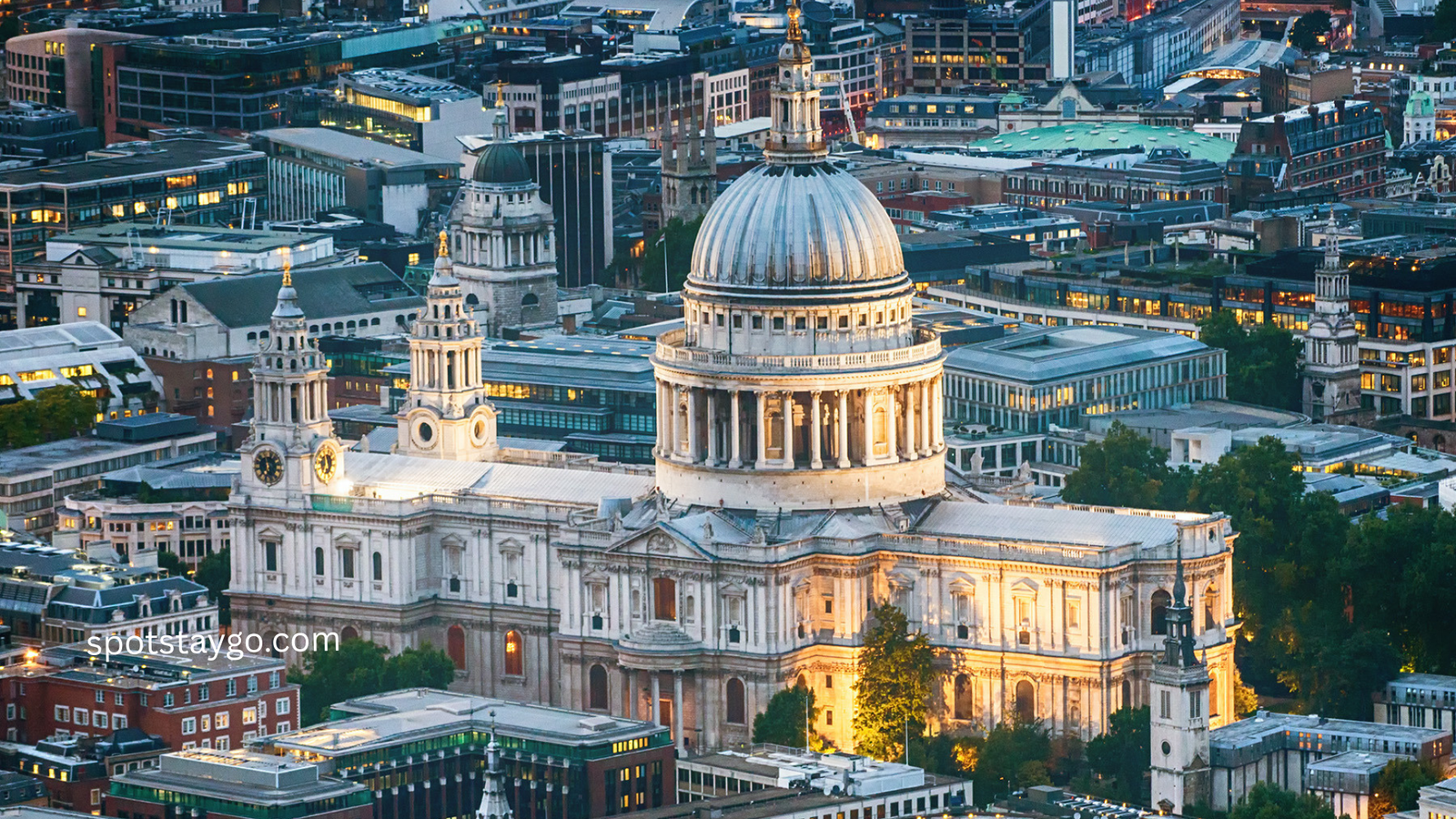Top 15 Ultimate London Destinations for 2025- London is the capital and largest city of both England and the United Kingdom. As one of the world’s leading global cities, London exerts a strong influence on art, entertainment, fashion, commerce, finance, education, healthcare, media, science, technology, tourism, transport, and communication. London is Europe’s most economically powerful city and one of the world’s major financial centers.
Top 15 Ultimate London Destinations for 2025, which included-
London is home to four UNESCO World Heritage Sites: The Tower of London, Kew Gardens, The Palace of Westminster (which includes Westminster Abbey and St Margaret’s Church), and Greenwich (home to the Royal Observatory, marking the Prime Meridian — 0 degrees longitude — and Greenwich Mean Time [GMT]).
Other iconic landmarks in London include Buckingham Palace, The London Eye, Piccadilly Circus, St Paul’s Cathedral, Tower Bridge, Trafalgar Square, and The Shard.
The city is also a hub of major museums, art galleries, libraries, and cultural institutions such as The British Museum, The National Gallery, The Natural History Museum, Tate Modern, The British Library, and the West End theatres.
In addition, London is served by the London Underground — the oldest underground railway network in the world.
Top 15 Ultimate London Destinations for 2025-
| The Tower of London | Kew Gardens | The Palace of Westminster | Greenwich |
| Buckingham Palace | The London Eye | Piccadilly Circus | St Paul’s Cathedral |
| Tower Bridge | Trafalgar Square | The Shard | The British Museum |
| The National Gallery | The Natural History Museum | Tate Modern | The British Library |
1. The Tower of London–
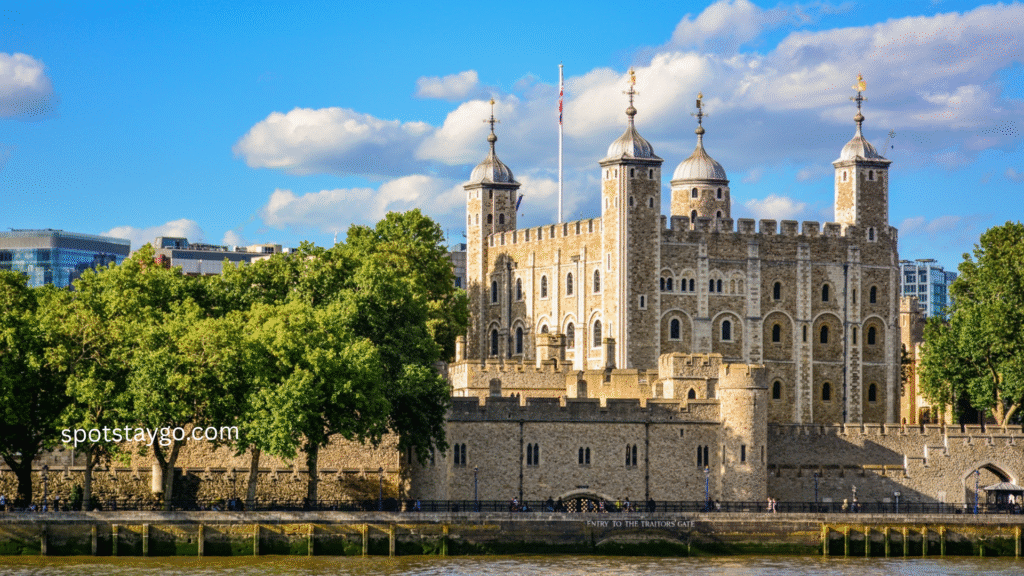
Situated on the banks of the River Thames in central London, this magnificent fortress stands as a historic symbol of the British capital. It was built in the year 1078 by William the Conqueror, using stones that were imported from France. The sprawling complex of the fortress houses several important buildings.
Once, this fortress served as a royal palace for the British monarchy. It also functioned as a prison for royal captives. Throughout history, it has witnessed numerous executions and acts of violence. Notably, King Henry VIII had his wife, Anne Boleyn, executed here in 1536.
Although the British royal family no longer resides in this fortress, the priceless royal Crown Jewels remain securely housed within its walls to this day.
2. Kew Gardens–
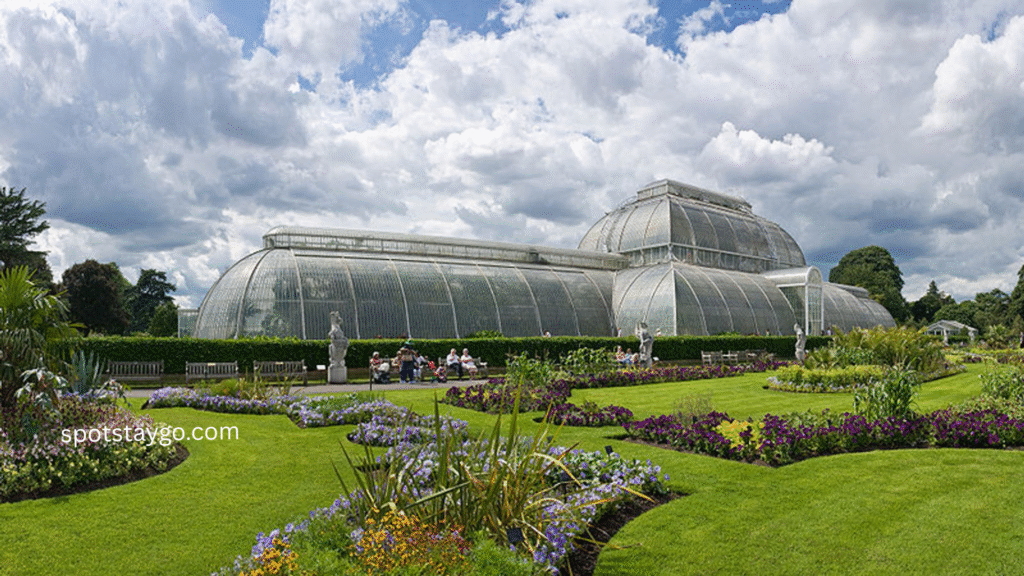
Kew Gardens, located in southwest London, is a renowned botanical garden known for housing the “largest and most diverse botanical and mycological collection in the world.” It was established in 1759 as an exotic garden within Kew Park.
The living collections at the Royal Botanic Gardens, Kew, include approximately 27,000 plant taxa. Additionally, its herbarium — one of the largest in the world — holds over 8.5 million preserved specimens of plants and fungi.
Kew Gardens also boasts an extensive library with more than 750,000 volumes and documents. Its illustration collection features over 175,000 prints and drawings related to plants.
It is one of London’s top tourist attractions and has been designated a UNESCO World Heritage Site.
3. The Palace of Westminster–
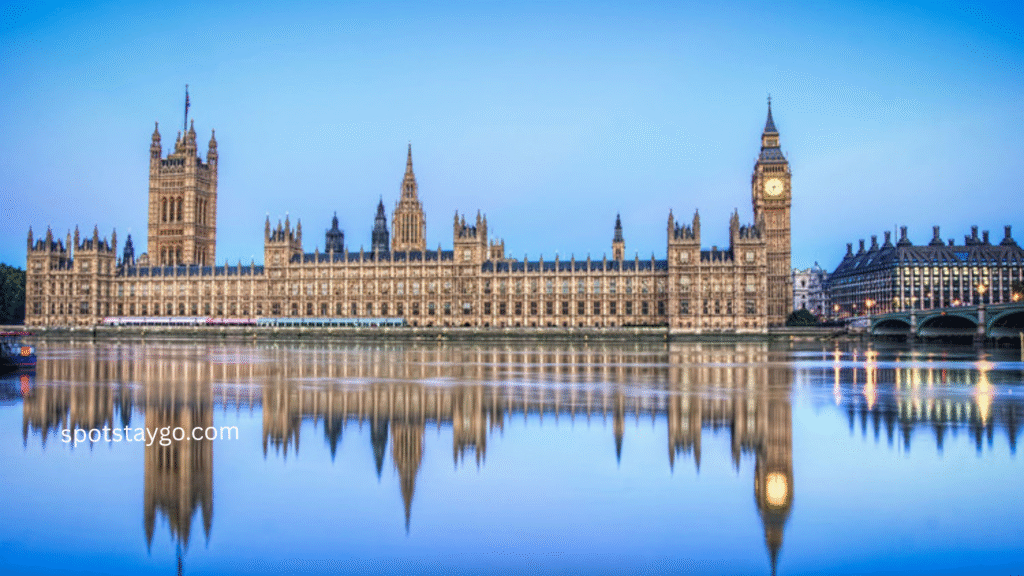
The Palace of Westminster, located in London, England, serves as the primary meeting place for the Parliament of the United Kingdom. Often called the “Houses of Parliament,” it is home to the two main legislative bodies — the House of Commons and the House of Lords.
As a cornerstone of British political life, the Palace has come to symbolize the UK government itself, with the term “Westminster” frequently used to refer to both Parliament and the broader system of governance. The renowned “Westminster system” of parliamentary democracy also takes its name from this iconic building.
One of its most famous features is the Elizabeth Tower, popularly known as “Big Ben,” which stands as a globally recognized symbol of London and the United Kingdom.
Designated a Grade I listed building in 1970, the Palace of Westminster has also been part of a UNESCO World Heritage Site since 1987.
4. Greenwich-
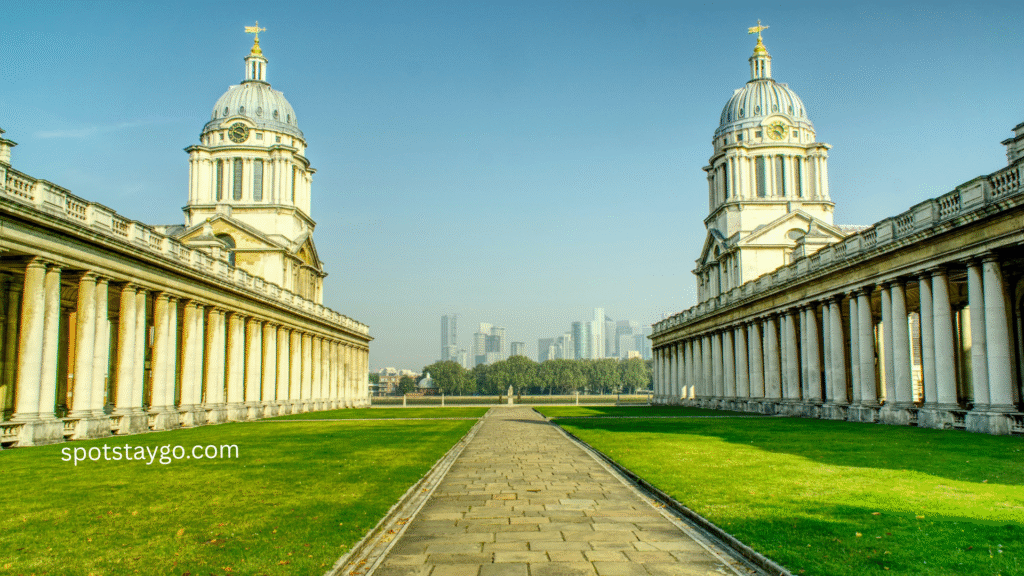
Greenwich is a historic area located in southeast London, England, within the ceremonial county of Greater London. It lies approximately 5.5 miles (8.9 kilometers) east-southeast of Charing Cross.
Greenwich is world-renowned for its rich maritime history, the Greenwich Meridian (0° longitude), and for giving its name to Greenwich Mean Time (GMT). Since the 15th century, the area was the site of the royal Palace of Placentia, the birthplace of several Tudor monarchs, including Henry VIII and Elizabeth I.
During the English Civil War, the palace fell into disrepair and was eventually demolished. In its place, the Royal Naval Hospital for sailors was constructed, designed by the celebrated architect Sir Christopher Wren and his assistant Nicholas Hawksmoor.
These buildings later became the Royal Naval College in 1873, serving as a military education institution until 1998, after which they were transferred to the Greenwich Foundation. Today, parts of the historic complex are open to the public, while other sections are used by the University of Greenwich and the Trinity Laban Conservatoire of Music and Dance.
5. Buckingham Palace-
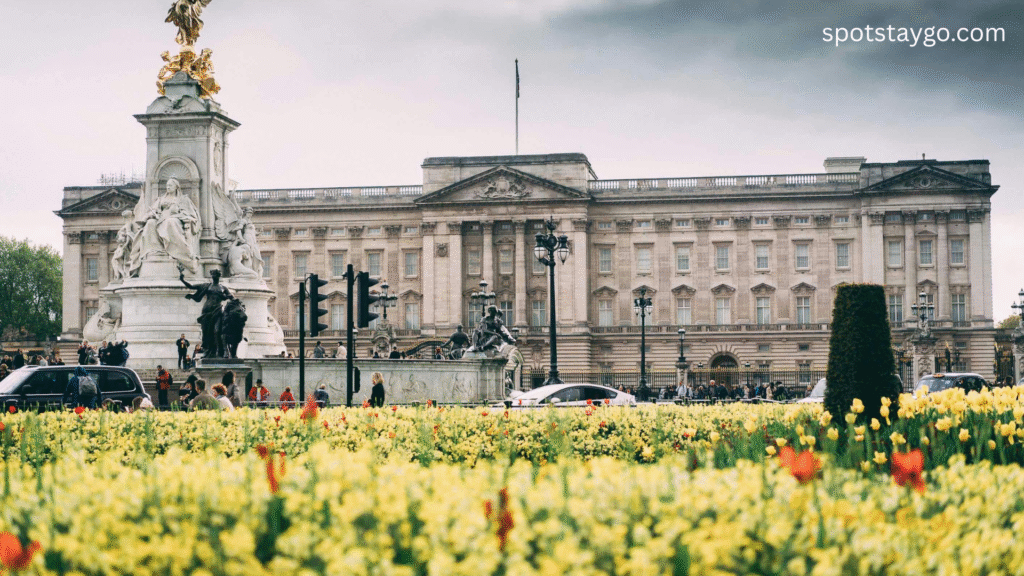
Buckingham Palace is a grand royal residence located in London and serves as the official administrative headquarters of the monarch of the United Kingdom. Situated in the City of Westminster, the palace is a central venue for state occasions and royal hospitality. It also serves as an emotional symbol for the British people during times of national celebration and mourning.
The palace began as Buckingham House—a large townhouse built in 1703 for the Duke of Buckingham and Normanby on a site that had been in private ownership for at least 150 years. In 1761, it was acquired by King George III as a private residence for his wife, Queen Charlotte.
Following the accession of Queen Victoria in 1837, Buckingham Palace became the official London residence of the British monarch.
6. The London Eye-
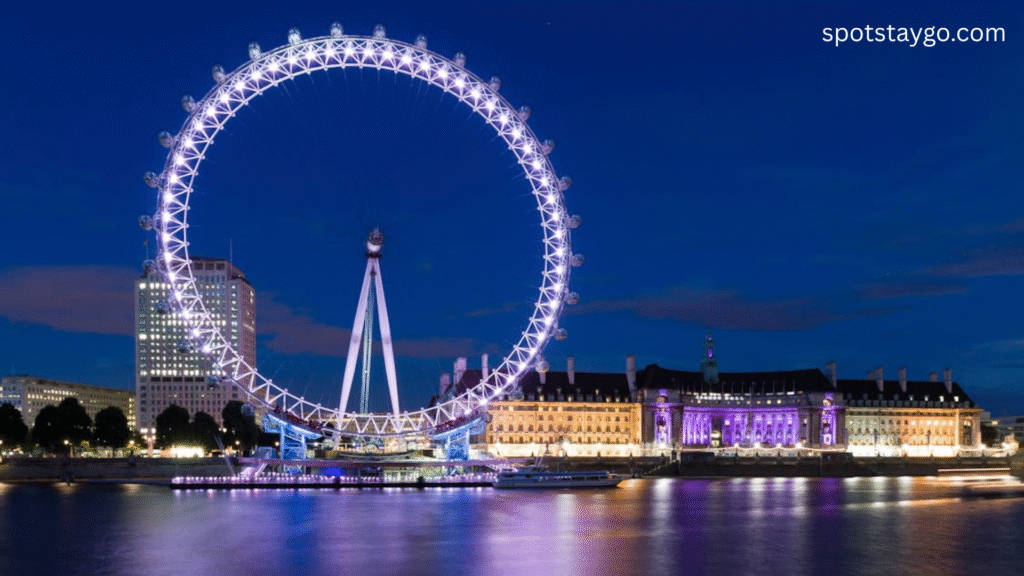
The London Eye, formerly known as the Millennium Wheel, is a cantilevered observation wheel located on the South Bank of the River Thames in London. It is the tallest cantilevered observation wheel in the world and the most popular paid tourist attraction in the United Kingdom, drawing over three million visitors annually. The London Eye has been featured numerous times in films and popular culture.
The structure stands at a height of 135 meters (443 feet) with a wheel diameter of 120 meters (394 feet). When it opened to the public in the year 2000, it held the title of the world’s tallest Ferris wheel. However, in 2006, it was surpassed by the 160-meter (525-foot) “Star of Nanchang” in China.
What makes the London Eye unique is its cantilevered design—it is supported only on one side by an A-frame, unlike most Ferris wheels which are supported on both sides.
Until 2013, the London Eye was the highest public viewing point in the city, but it was overtaken by the observation deck known as “The View from The Shard,” which stands at 245 meters (804 feet) tall.
7. Piccadilly Circus-
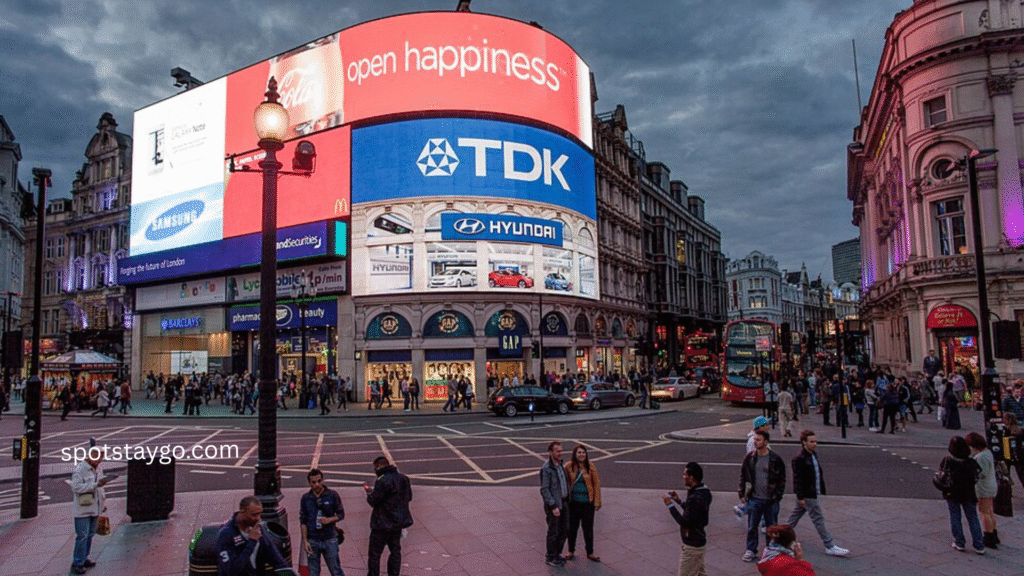
Piccadilly Circus is a major road junction and public space located in the City of Westminster, at the heart of London’s West End. It was created in 1819 to connect Regent Street with Piccadilly. The term “Circus” comes from the Latin word meaning “circle,” and refers to a circular open space at a street junction.
Today, Piccadilly Circus links Piccadilly, Regent Street, Shaftesbury Avenue, Haymarket, Coventry Street (which leads to Leicester Square), and Glasshouse Street. It is situated near key shopping and entertainment areas in the West End.
Due to its central location and heavy traffic flow, Piccadilly Circus has become a popular meeting point and a major tourist attraction in its own right. It is especially known for the large video displays and neon signs mounted on the buildings to its north. One of its most iconic features is the Shaftesbury Memorial Fountain, topped with the statue of Anteros—commonly, though mistakenly, referred to as Eros.
8. St Paul’s Cathedral–

St. Paul’s Cathedral, formally known as the Cathedral Church of St. Paul the Apostle, is an Anglican cathedral located in London, England. It serves as the official seat of the Bishop of London and is the mother church of the Diocese of London within the Church of England.
This historic structure stands on Ludgate Hill, the highest point in the City of London. The cathedral is dedicated to St. Paul the Apostle, continuing a tradition that dates back to the original church established on this site in 604 AD.
The present building, renowned for its magnificent dome, was completed in 1710. It was designed in the English Baroque style by the eminent architect Sir Christopher Wren. St. Paul’s Cathedral is a Grade I listed building and was constructed as part of a major rebuilding program following the Great Fire of London in 1666.
9. Tower Bridge-
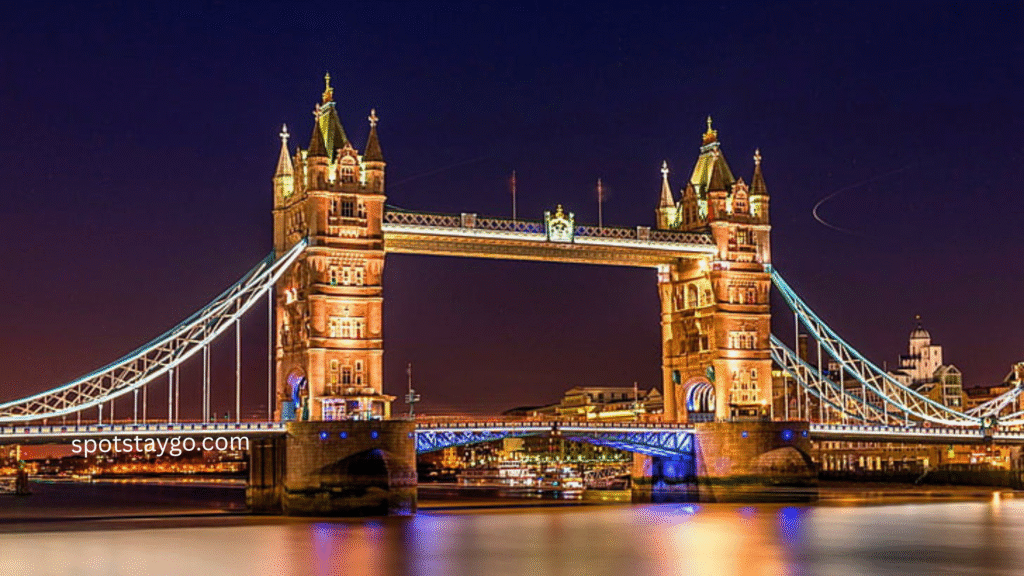
Tower Bridge is a Grade I listed bridge in London, known for its bascule (drawbridge), suspension, and — until 1960 — cantilever design. Constructed between 1886 and 1894, it was designed by architect Horace Jones and engineered by Sir John Wolfe Barry with assistance from Henry Marc Brunel. The bridge crosses the River Thames near the Tower of London and is one of five major London bridges owned and maintained by the City Bridge Foundation, a charitable trust established in 1282.
The bridge was built to connect the 39% of London’s population living east of London Bridge — a number roughly equal to the combined populations of Manchester and Liverpool at the time. Its design allowed ships to continue accessing the Pool of London, the area between the Tower of London and London Bridge.
Tower Bridge was officially opened on 30 June 1894 by the Prince of Wales (later King Edward VII) and Princess Alexandra.
10. Trafalgar Square-
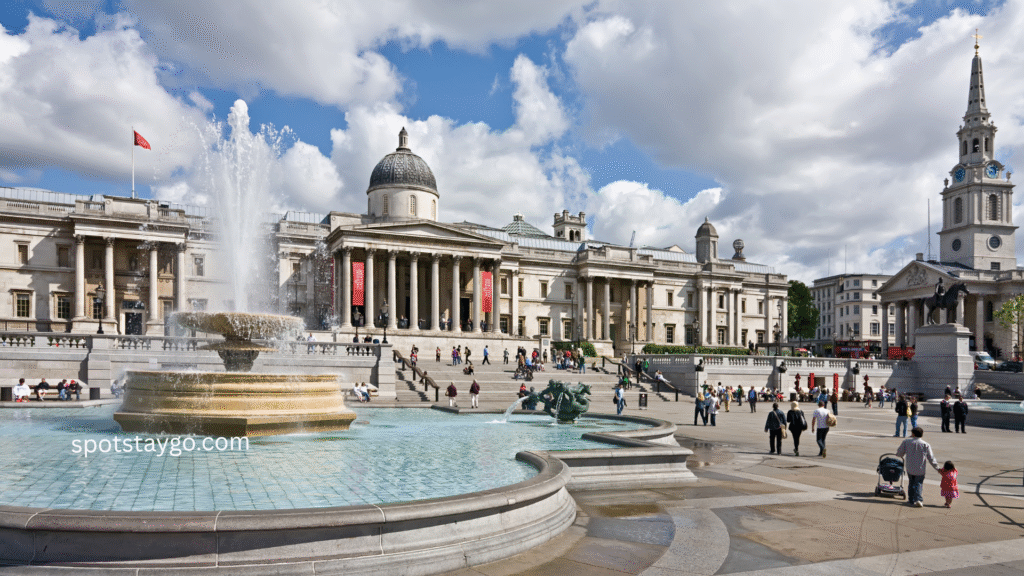
Trafalgar Square is a prominent public square located in the City of Westminster, Central London. It was developed in the early 19th century around the area known as Charing Cross. The square is named in commemoration of the Battle of Trafalgar, a major naval victory for the British Royal Navy over the French and Spanish fleets on 21 October 1805 off the coast of Cape Trafalgar.
The area of Trafalgar Square has been of historical importance since the 13th century. For centuries, Charing Cross was considered the central point of London, from which distances were traditionally measured. The site of the present-day square was originally occupied by the royal stables known as the “King’s Mews.” After King George IV moved the mews to Buckingham Palace, architect John Nash began redeveloping the area. However, progress slowed after Nash’s death, and the square was not officially opened until 1844.
At the center of the square stands Nelson’s Column, a 169-foot (52-meter) tall monument dedicated to the famed British admiral Horatio Nelson. The column is guarded by four large bronze lion statues. The square features numerous other statues and memorials, but the “Fourth Plinth”—which remained empty since 1840—has been used for contemporary art installations since 1999.
Prominent buildings surrounding Trafalgar Square include the National Gallery, St Martin-in-the-Fields Church, Canada House, and South Africa House.
11. The Shard–
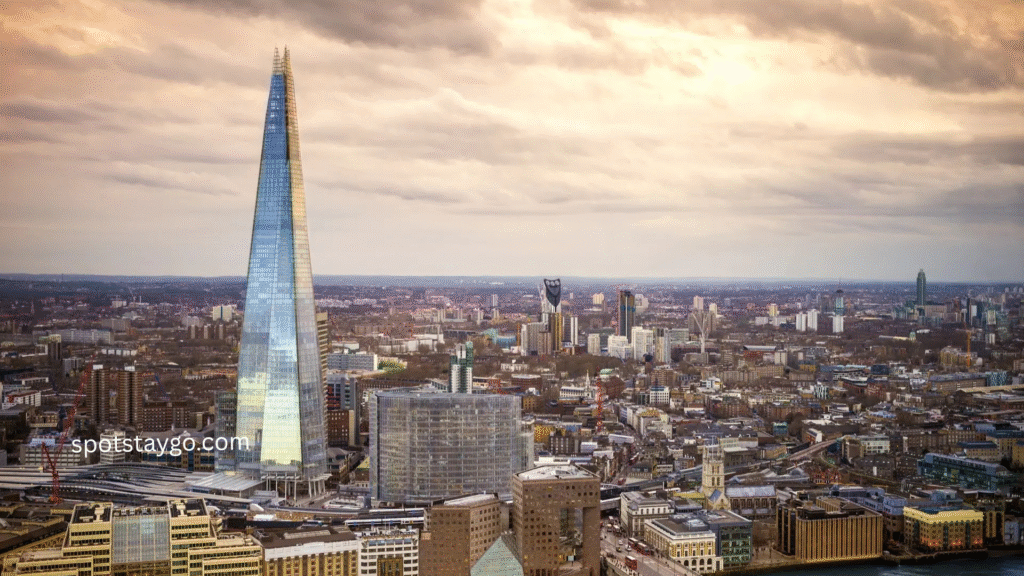
The Shard, formerly known as the London Bridge Tower and now also referred to as Shard London Bridge, is a 72-storey mixed-use supertall skyscraper. Designed in a pyramidal shape by renowned Italian architect Renzo Piano, it is located in the Southwark area of London and forms a key part of the “Shard Quarter” development project.
Standing at a height of 309.6 meters (1,016 feet), The Shard is the tallest building in the United Kingdom. It is also the seventh-tallest building in Europe and the second-tallest structure outside Russia—surpassed only by the Varso Tower in Warsaw, which is taller by less than half a meter.
The Shard was constructed on the site of the former Southwark Towers, a 24-storey office building that had stood there since 1975.
12. The British Museum–
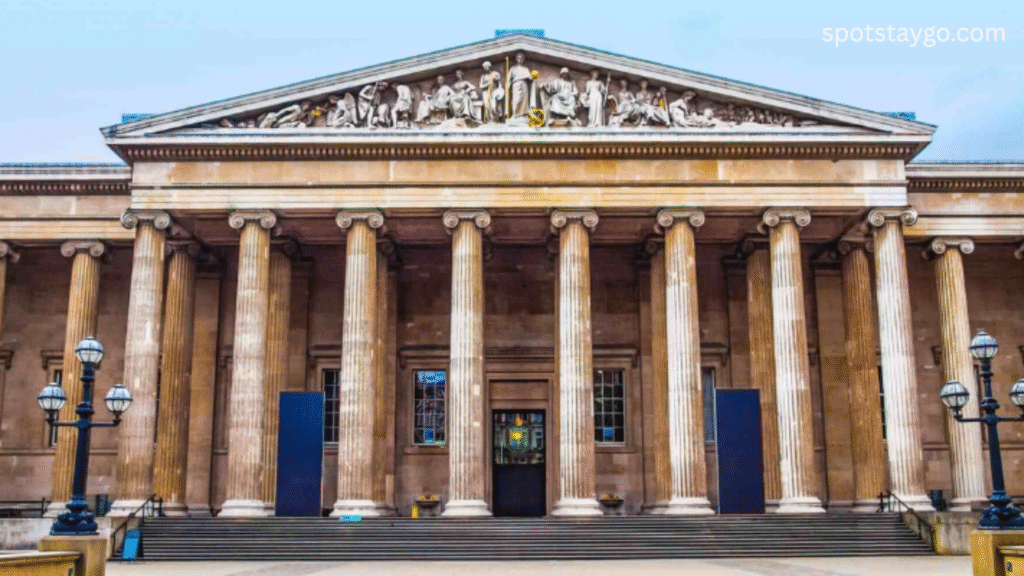
The British Museum is a public museum located in the Bloomsbury area of London, dedicated to human history, art, and culture. Its permanent collection comprises more than eight million works, making it one of the largest and most comprehensive collections in the world. The museum documents the story of human civilization from its beginnings to the present day.
Established in 1753, the British Museum was the world’s first public national museum. It opened to the public in 1759 at Montagu House, located on the site of the current building. The museum was founded largely on the personal collection of Anglo-Irish physician and scientist Sir Hans Sloane.
Over the next 250 years, the museum expanded significantly, much of which was influenced by British colonialism. This growth led to the establishment of several branch institutions or independent spin-offs, the first of which was the Natural History Museum in 1881.
Some of the museum’s most famous holdings — such as the Greek Elgin Marbles and the Egyptian Rosetta Stone — have long been the subject of controversy and calls for repatriation to their countries of origin.
In 2023, the museum welcomed a total of 5,820,860 visitors, a 42% increase compared to the previous year. At least one organization ranked it as the most popular tourist attraction in the United Kingdom.
13. The National Gallery–
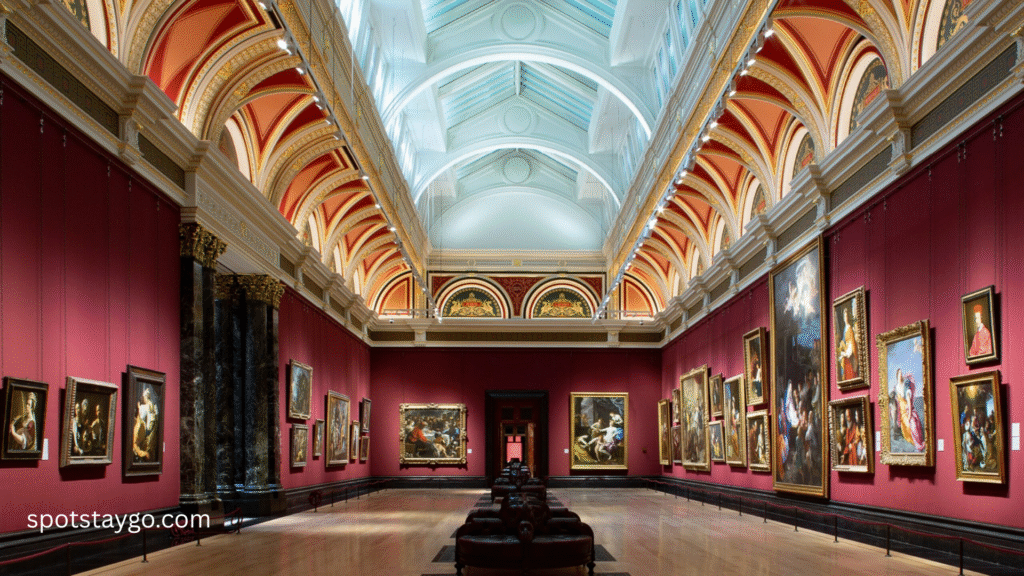
The National Gallery is a prominent art museum located in Trafalgar Square in the City of Westminster, Central London, England. Established in 1824, it houses a collection of over 2,300 paintings dating from the mid-13th century to 1900. The current director of the National Gallery is Gabrielle Finaldi.
The gallery is a recognized charitable institution and operates as a non-departmental public body under the Department for Culture, Media and Sport (DCMS). The collection is owned by the British government on behalf of the public, and entry to the main collection is free of charge.
Unlike many museums in continental Europe, the National Gallery was not founded by nationalizing an existing royal or state art collection. Instead, it began when the British government purchased 38 paintings from the estate of John Julius Angerstein in 1824.
14. The Natural History Museum–
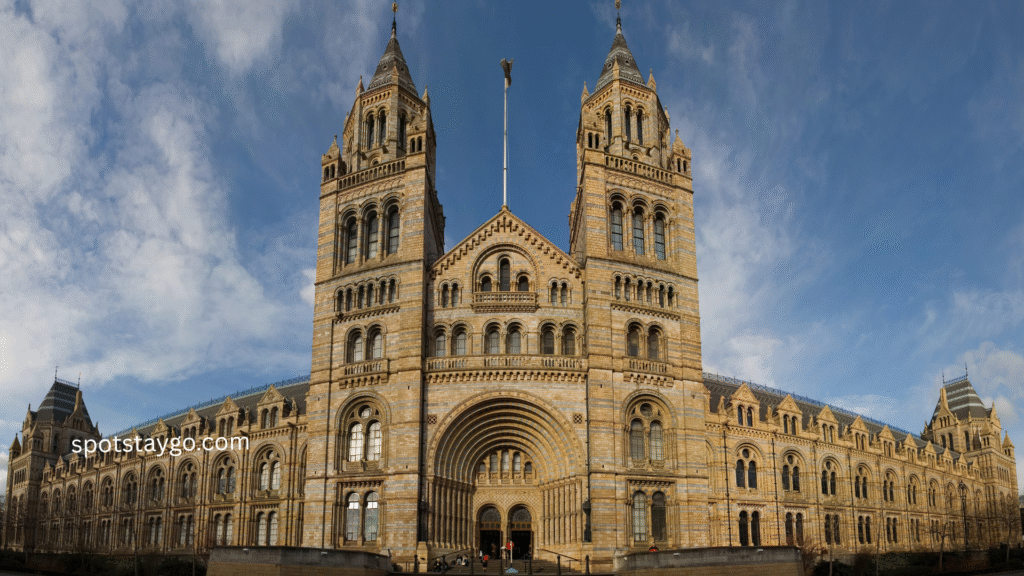
A natural history museum is a scientific institution that houses collections related to natural history. These collections typically include specimens from animals, plants, fungi, ecosystems, geology, paleontology, climatology, and other related fields, both current and historical.
The primary purpose of such museums is to provide the scientific community with access to specimens for research, with the aim of deepening our understanding of the natural world.
Many natural history museums also feature public exhibitions designed to share the beauty and diversity of nature with visitors. These are known as “public museums.” In addition to their primary collections, some museums also display non-natural history items, such as collections related to history, art, and science.
15. Tate Modern–
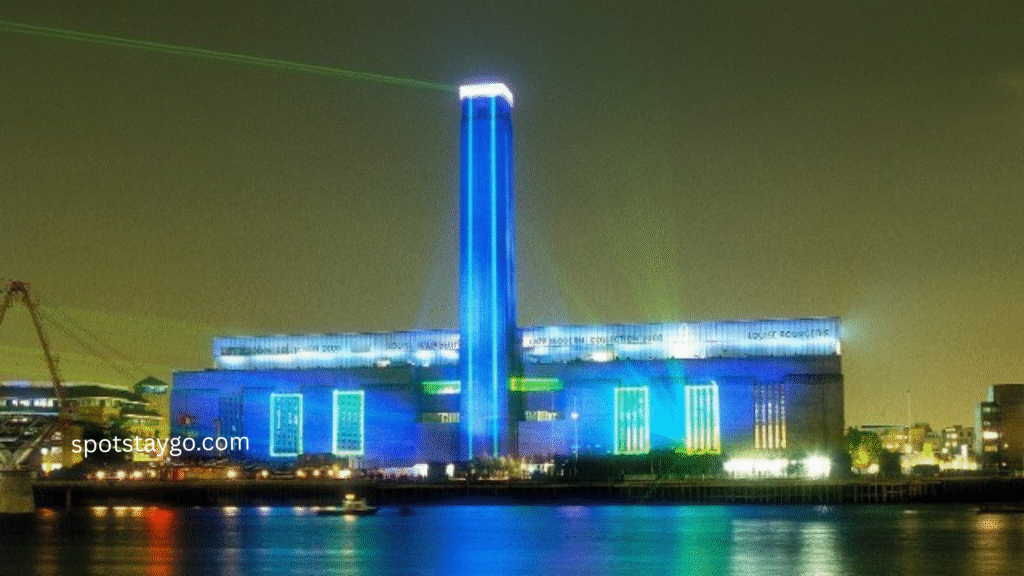
Tate Modern is a major art gallery located in London, housing the United Kingdom’s national collection of international modern and contemporary art (from 1900 onwards). It is part of the Tate group, which also includes Tate Britain, Tate Liverpool, and Tate St Ives. The gallery is situated in the Bankside area of the London Borough of Southwark and is housed in the former Bankside Power Station.
Tate Modern is one of the largest museums of modern and contemporary art in the world. Like other UK national galleries and museums, there is no admission fee for access to the permanent exhibitions, which occupy the majority of the gallery’s space. However, tickets are required for certain major temporary exhibitions.
Top 10 Must-visit cities in Europe for 2025
The perfect 7 days South Africa tour
